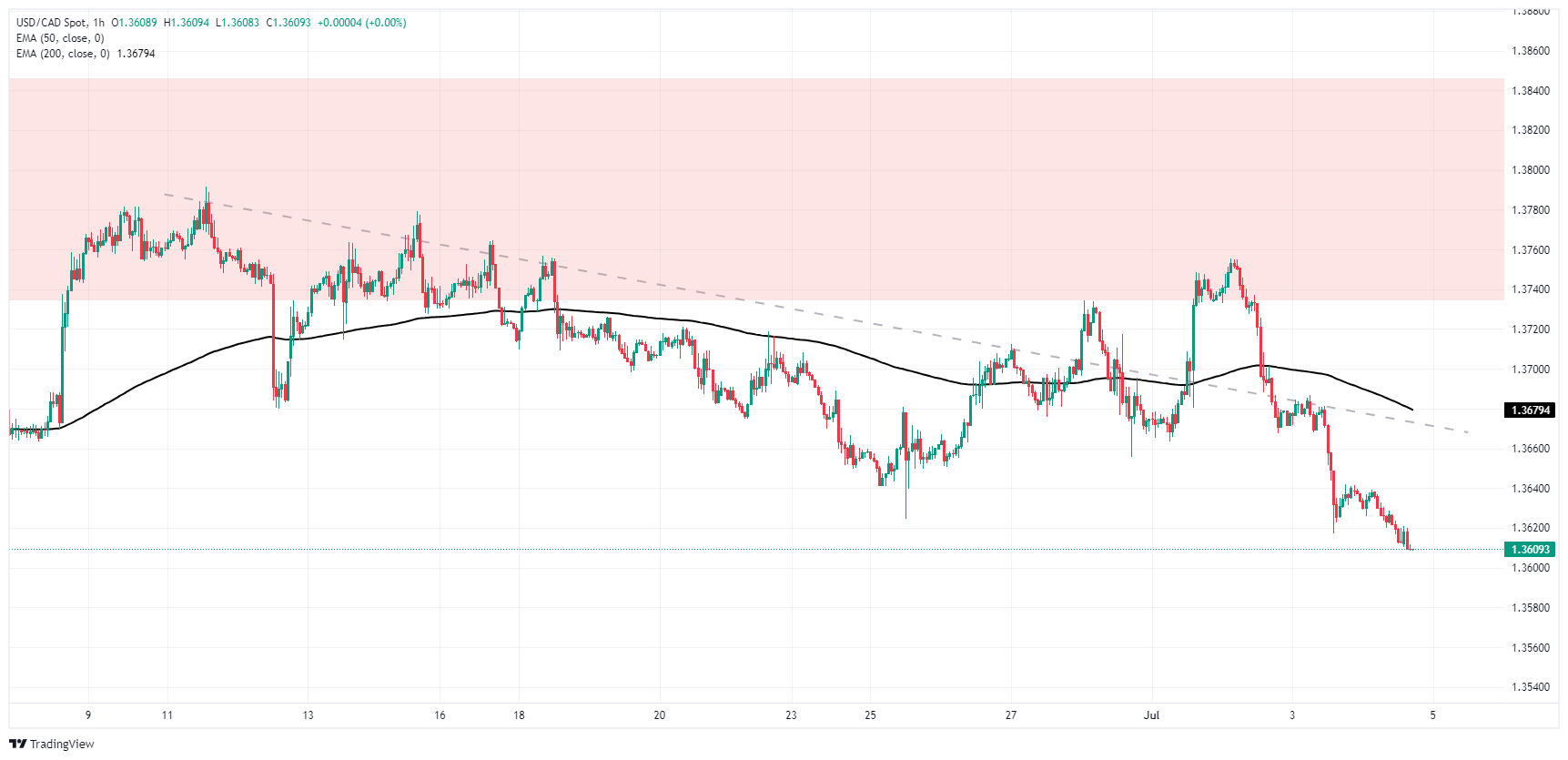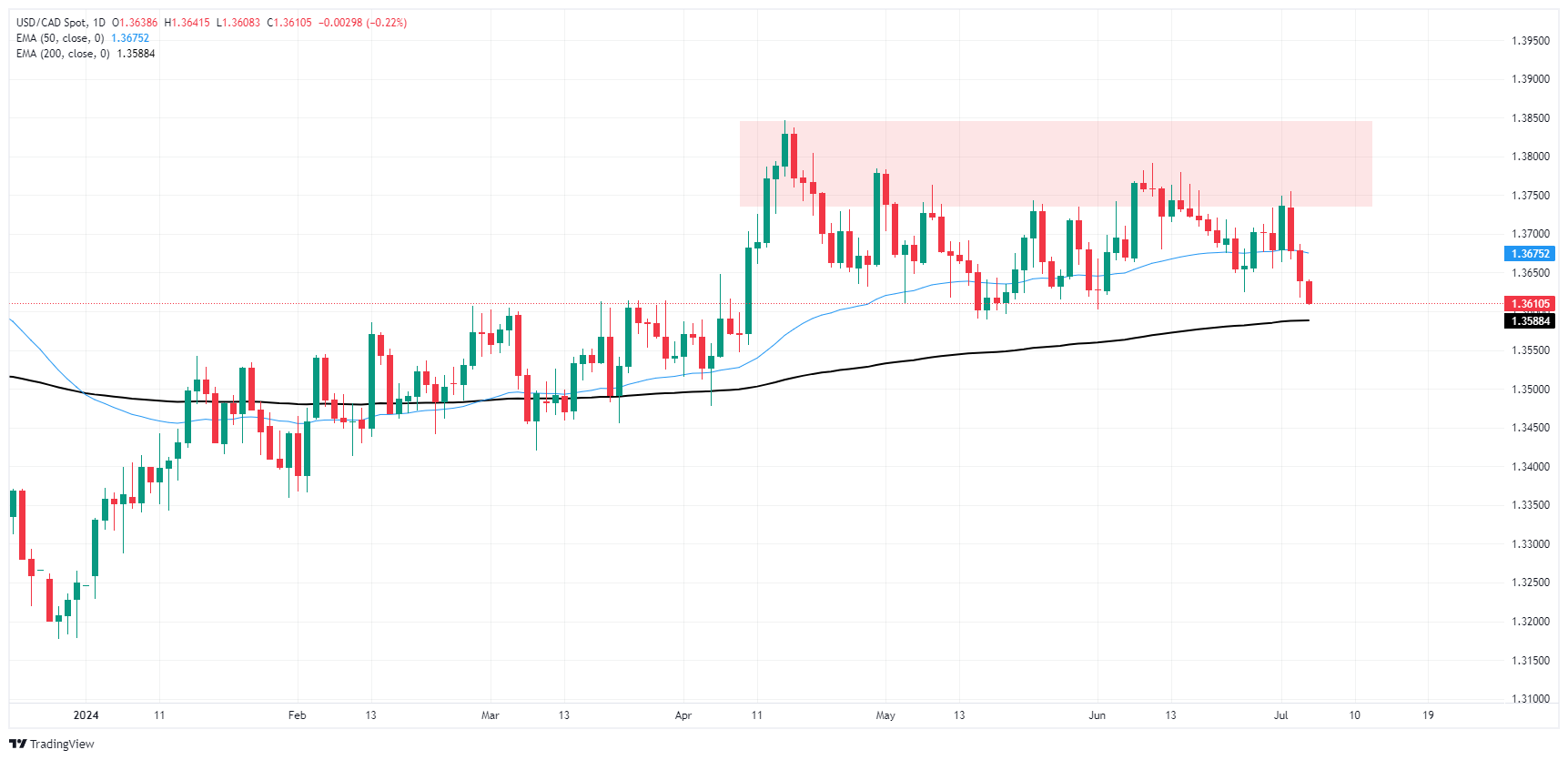- Analiza
- Novosti i instrumenti
- Vesti sa tržišta
- Canadian Dollar finds mixed gains on quiet Thursday
Canadian Dollar finds mixed gains on quiet Thursday
- Canadian Dollar stretched into a third day of gains against the Greenback.
- Canada is absent from the economic calendar on Thursday.
- US markets are also shuttered for the holiday, leaving a lull in market volume.
The Canadian Dollar (CAD) rose into a third consecutive day of gains against the US Dollar as Thursday markets grind away quietly. A lack of notable data has left both the CAD and the USD adrift, giving market participants a breather before Friday’s heady US Nonfarm Payrolls (NFP) jobs data dump.
Canada and the US are both absent from the economic calendar on Thursday. US markets are darkened for the Independence Day holiday, while Canada has nothing useful to say. Friday is set to be a volatile capstone on the trading week, with US NFP set to eclipse Canadian labor figures entirely.
Daily digest market movers: Canadian Dollar eases into higher gains on tepid Thursday
- Market focus will shift to Friday amid a flat Canadian release schedule and US holiday.
- June’s Canadian Net Change in Employment is expected to ease to 22.5K from the previous 26.7K.
- The Canadian Unemployment Rate is forecast to tick higher to 6.3% from 6.2%.
- Annualized Canadian Average Hourly Wages for the year ended in June will also be published. Canadian wages last printed 5.2% YoY growth.
- US NFP net job gains are forecast to ease to 190K in June, down from the previous 272K.
- US Average Hourly Earnings are also expected to moderate further, forecast to tick down to 0.3% MoM in June, down from the previous 0.4%.
Canadian Dollar PRICE Today
The table below shows the percentage change of Canadian Dollar (CAD) against listed major currencies today. Canadian Dollar was the strongest against the US Dollar.
| USD | EUR | GBP | JPY | CAD | AUD | NZD | CHF | |
|---|---|---|---|---|---|---|---|---|
| USD | -0.21% | -0.14% | -0.35% | -0.21% | -0.33% | -0.29% | -0.18% | |
| EUR | 0.21% | 0.08% | -0.10% | 0.00% | -0.09% | -0.07% | 0.08% | |
| GBP | 0.14% | -0.08% | -0.21% | -0.07% | -0.18% | -0.15% | -0.05% | |
| JPY | 0.35% | 0.10% | 0.21% | 0.14% | 0.02% | 0.06% | 0.16% | |
| CAD | 0.21% | -0.01% | 0.07% | -0.14% | -0.11% | -0.05% | 0.02% | |
| AUD | 0.33% | 0.09% | 0.18% | -0.02% | 0.11% | 0.06% | 0.14% | |
| NZD | 0.29% | 0.07% | 0.15% | -0.06% | 0.05% | -0.06% | 0.08% | |
| CHF | 0.18% | -0.08% | 0.05% | -0.16% | -0.02% | -0.14% | -0.08% |
The heat map shows percentage changes of major currencies against each other. The base currency is picked from the left column, while the quote currency is picked from the top row. For example, if you pick the Canadian Dollar from the left column and move along the horizontal line to the US Dollar, the percentage change displayed in the box will represent CAD (base)/USD (quote).
Technical analysis: Canadian Dollar claws back further ground from Greenback
The Canadian Dollar (CAD) is shifting moderately higher on Thursday, climbing around one-fifth of one percent against the US Dollar (USD). The CAD also gained a scant one-tenth of one percent against the Pound Sterling (GBP) and the Swiss Franc (CHF), but shed around the same against the recovering Japanese Yen (JPY).
USD/CAD is grinding lower, dropping away from Thursday’s early high bids around 1.3640, heading for the 1.3600 handle. A clean downside break of 1.3600 sets the pair up for a renewed challenge of the 200-day Exponential Moving Average (EMA) at 1.3588. Daily candles have collected a significant amount of bearish pressure from a supply zone baked in above 1.2750, and USD/CAD bids are getting squeezed into a high-pressure zone just above long-term moving averages.
USD/CAD hourly chart
USD/CAD daily chart
Canadian Dollar FAQs
The key factors driving the Canadian Dollar (CAD) are the level of interest rates set by the Bank of Canada (BoC), the price of Oil, Canada’s largest export, the health of its economy, inflation and the Trade Balance, which is the difference between the value of Canada’s exports versus its imports. Other factors include market sentiment – whether investors are taking on more risky assets (risk-on) or seeking safe-havens (risk-off) – with risk-on being CAD-positive. As its largest trading partner, the health of the US economy is also a key factor influencing the Canadian Dollar.
The Bank of Canada (BoC) has a significant influence on the Canadian Dollar by setting the level of interest rates that banks can lend to one another. This influences the level of interest rates for everyone. The main goal of the BoC is to maintain inflation at 1-3% by adjusting interest rates up or down. Relatively higher interest rates tend to be positive for the CAD. The Bank of Canada can also use quantitative easing and tightening to influence credit conditions, with the former CAD-negative and the latter CAD-positive.
The price of Oil is a key factor impacting the value of the Canadian Dollar. Petroleum is Canada’s biggest export, so Oil price tends to have an immediate impact on the CAD value. Generally, if Oil price rises CAD also goes up, as aggregate demand for the currency increases. The opposite is the case if the price of Oil falls. Higher Oil prices also tend to result in a greater likelihood of a positive Trade Balance, which is also supportive of the CAD.
While inflation had always traditionally been thought of as a negative factor for a currency since it lowers the value of money, the opposite has actually been the case in modern times with the relaxation of cross-border capital controls. Higher inflation tends to lead central banks to put up interest rates which attracts more capital inflows from global investors seeking a lucrative place to keep their money. This increases demand for the local currency, which in Canada’s case is the Canadian Dollar.
Macroeconomic data releases gauge the health of the economy and can have an impact on the Canadian Dollar. Indicators such as GDP, Manufacturing and Services PMIs, employment, and consumer sentiment surveys can all influence the direction of the CAD. A strong economy is good for the Canadian Dollar. Not only does it attract more foreign investment but it may encourage the Bank of Canada to put up interest rates, leading to a stronger currency. If economic data is weak, however, the CAD is likely to fall.
© 2000-2024. Sva prava zaštićena.
Sajt je vlasništvo kompanije Teletrade D.J. LLC 2351 LLC 2022 (Euro House, Richmond Hill Road, Kingstown, VC0100, St. Vincent and the Grenadines).
Svi podaci koji se nalaze na sajtu ne predstavljaju osnovu za donošenje investicionih odluka, već su informativnog karaktera.
The company does not serve or provide services to customers who are residents of the US, Canada, Iran, The Democratic People's Republic of Korea, Yemen and FATF blacklisted countries.
Izvršenje trgovinskih operacija sa finansijskim instrumentima upotrebom marginalne trgovine pruža velike mogućnosti i omogućava investitorima ostvarivanje visokih prihoda. Međutim, takav vid trgovine povezan je sa potencijalno visokim nivoom rizika od gubitka sredstava. Проведение торговых операций на финанcовых рынках c маржинальными финанcовыми инcтрументами открывает широкие возможноcти, и позволяет инвеcторам, готовым пойти на риcк, получать выcокую прибыль, но при этом неcет в cебе потенциально выcокий уровень риcка получения убытков. Iz tog razloga je pre započinjanja trgovine potrebno odlučiti o izboru odgovarajuće investicione strategije, uzimajući u obzir raspoložive resurse.
Upotreba informacija: U slučaju potpunog ili delimičnog preuzimanja i daljeg korišćenja materijala koji se nalazi na sajtu, potrebno je navesti link odgovarajuće stranice na sajtu kompanije TeleTrade-a kao izvora informacija. Upotreba materijala na internetu mora biti praćena hiper linkom do web stranice teletrade.org. Automatski uvoz materijala i informacija sa stranice je zabranjen.
Ako imate bilo kakvih pitanja, obratite nam se pr@teletrade.global.















